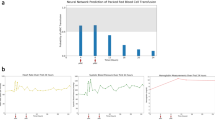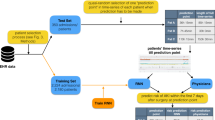Abstract
Coronary Artery Bypass Graft (CABG) is a common cardiac surgery, but it continues to have many associated risks, including the need for blood transfusions. Previous research has shown that blood transfusion during CABG surgery is associated with an increased risk for infection and mortality. The current study aims to use modern techniques, such as deep neural networks and data synthesis, to develop models that can best predict the need for blood transfusion among CABG patients. Results show that neural networks with synthetic data generated by DataSynthesizer have the best performance. Implications of results and future directions are discussed.



Similar content being viewed by others
Explore related subjects
Discover the latest articles, news and stories from top researchers in related subjects.Data availability
The data utilized in this study are not publicly available. The Participant Use Data File (PUF) is a Health Insurance Portability and Accountability Act (HIPAA)-compliant data file containing cases submitted to the American College of Surgeons National Surgical Quality Improvement Program (ACS NSQIP). PUF access is reserved for participating staff and hospitals. Requests for participation can be made directly to ACS, where the individual requests will be reviewed, and data can be downloaded upon approval. Please refer to the ACS NSQIP website at: https://www.facs.org/quality-programs/dataand-registries/acs-nsqip/participant-use-data-file/.
References
Horvath K, Acker M, Chang H, Bagiella E et al (2013) Blood transfusion and infection after cardiac surgery. Ann Thorac Surg 95(6):2194–2201. https://doi.org/10.1016/j.athoracsur.2012.11.078
Kaur D, Sobiesk M, Patil S, Liu J, Bhagat P, Gupta A, Markuzon N (2021) Application of Bayesian networks to generate synthetic health data. J Am Med Inform Assoc 28(4):801–811. https://doi.org/10.1093/jamia/ocaa303
Li Q, Lv H, Chen Y, Shen J, Shi J, Zhou C (2024) Development and validation of a machine learning prediction model for perioperative red blood cell transfusions in cardiac surgery. Int J Med Inform 184:105343. https://doi.org/10.1016/j.ijmedinf.2024.105343
Mufarrih S, Mahmood F, Qureshi N, Yunus R, Matyal R et al (2023) Timing of blood transfusions and 30-days patient outcomes after coronary artery bypass graft surgery. J Cardiothorac Vasc Anesth 37(3):382–391. https://doi.org/10.1053/j.jvca.2022.11.029
Gao Y, Liu X, Wang L, Wang S, Yu Y, Ding Y, Wang J, Ao H (2022) Machine learning algorithms to predict major bleeding after isolated coronary artery bypass grafting. Front Cardiovasc Med 9:881881. https://doi.org/10.3389/fcvm.2022.881881
Tschoellitsch T, Bock C, Mahecic T, Hofmann A, Meier J (2022) Machine learning-based prediction of massive perioperative allogeneic blood transfusion in cardiac surgery. Eur J Anaesthesiol 39(9):766–773. https://doi.org/10.1097/EJA.0000000000001721
Hagan MT, Demuth HB, Beale MH, De Jesús O (2014) Neural network design (2nd Edition). https://hagan.okstate.edu/NNDesign.pdf
Wu YC, Feng JW (2018) Development and application of artificial neural network. Wirel Pers Commun 102:1645–1656. https://doi.org/10.1007/s11277-017-5224-x
McCulloch WS, Pitts W (1943) A logical calculus of the ideas immanent in nervous activity. Bull Math Biol 5:115–133. https://doi.org/10.1007/BF02478259
Macukow B (2016) Neural networks – state of art, brief history, basic models and architecture. CISIM 9:3–14. https://doi.org/10.1007/978-3-319-45378-1_1
Carpenter GA, Grossberg S (1987) A massively parallel architecture for a self-organizing neural pattern recognition machine. Comput Vis Image Proc 37(1):54–115. https://doi.org/10.1016/S0734-189X(87)80014-2
Schmidhuber S, Hochreiter J (1997) Long short-term memory. Neural Comput 9(8):1735–1780. https://doi.org/10.1162/neco.1997.9.8.1735
Borisov V, Leemann T, Seßler K, Haug J, Pawelczyk M, Kasneci G (2022) Deep neural networks and tabular data: a survey. IEEE Trans Neural Netw Learn Syst. https://doi.org/10.1109/TNNLS.2022.3229161
Gorishniy Y, Rubachev I, Khrulkov V, Babenko A (2021) Revisiting deep learning models for tabular data. arXiv. https://doi.org/10.48550/arXiv.2106.11959
Shwartz-Ziv R, Armon A (2021) Tabular data: deep learning is not all you need. arXiv. https://doi.org/10.48550/arXiv.2106.03253
Sánchez-Morales A, Sancho-Gómez JL, Martínez-García JA et al (2020) Improving deep learning performance with missing values via deletion and compensation. Neural Comput Applic 32:13233–13244. https://doi.org/10.1007/s00521-019-04013-2
Xu L, Veeramachaneni K (2018) Synthesizing tabular data using generative adversarial networks. arXiv. https://doi.org/10.48550/arXiv.1811.11264
Zhu Y, Brettin T, Xia F, Partin A, Shukla M, Yoo H, Evrard YA (2021) Converting tabular data into images for deep learning with convolutional neural networks. Sci Rep 11(1):14036. https://doi.org/10.1038/s41598-021-93376-5
Hancock JT, Khoshgoftaar TM (2020) Survey on categorical data for neural networks. J Big Data 7:28. https://doi.org/10.1186/s40537-020-00305-w
Fitkov-Norris E, Vahid S, Hand C (2012) Evaluating the impact of categorical data encoding and scaling on neural network classification performance: the case of repeat consumption of identical cultural goods. Eng Appl Neural Netw. https://doi.org/10.1007/978-3-642-32909-8_35
Shavitt I, Segal E (2018) Regularization learning networks deep learning for tabular datasets. Neural Inform Process Syst https://doi.org/10.48550/arXiv.1805.06440
Katzir L, Elidan G, El-Yaniv R (2021) Net-DNF: effective deep modeling of tabular data. Int Conf Learn Rep
Popov S, Morozov S, Babenko A (2019) Neural oblivious decision ensembles for deep learning on tabular data. arXiv. https://doi.org/10.48550/arXiv.1909.06312
Somepalli G, Goldblum M, Schwarzschild A, Bruss CB, Goldstein T (2021) SAINT: Improved neural networks for tabular data via row attention and contrastive pre-training. arXiv. https://doi.org/10.48550/arXiv.2106.01342
Clements JM, Xu D, Yousefi N, Efimov D (2020) Sequential deep learning for credit risk monitoring with tabular financial data. arXiv. https://doi.org/10.48550/arXiv.2012.15330
Young J, Graham P, Penny R (2009) Using Bayesian networks to create synthetic data. J Off Stat 25(4):549–567
Di Zio M, Scanu M, Coppola L, Luzi O, Ponti A (2004) Bayesian networks for imputation. J R Stat Soc 167:309–322
Baowaly M, Lin C, Liu C, Chen K (2019) Synthesizing electronic health records using improved generative adversarial networks. J Am Med Inform Assoc 26(3):228–241. https://doi.org/10.1093/jamia/ocy142
Ping H, Stoyanovich J, Howe B (2017) DataSynthesizer: privacy-preserving synthetic datasets. Int Conf Sci Stat Database Manage. https://doi.org/10.1145/3085504.3091117
Zhang J, Cormode G, Procopiuc C, Strivastava D, Xiao X (2014) PrivBayes: private data release via bayesian networks. SIGMOD Int Conf Manage Data 42(4):1–41
Solatorio A, Dupriez O (2023) REaLTabFormer: Generating realistic and tabular data using Transformers. arXiv. https://doi.org/10.48550/arxiv.2302.02041
Padhi I, Schiff Y, Melnyk I, Rigotti M, Mroueh Y, Dognin P, Ross J, Nair R, Altman E (2021) Tabular transformers for modeling multivariate time series. IEEE. https://doi.org/10.1109/ICASSP39728.2021.9414142
Acknowledgments
Special thanks to the Data Science program at George Washington University, who provided the Capstone project opportunity and brought all the authors together to work on this research.
Funding
No funding was received to assist with the preparation of this manuscript.
Author information
Authors and Affiliations
Contributions
Professor Amir Jafari is the advisor of this research project, overseeing the entire project and providing guidance in data science/neural networks. Hsiao-Tien Tsai conducted data preprocessing, EDA, synthetic data generation, FNN modeling, and the related write-ups, as well as discussions and conclusion. Jichong Wu conducted the literature review in neural networks and performed CNN modeling and the related write-ups. Dr. Puneet Gupta and Dr. Eric R Heinz contributed to the literature review in cardiac surgery and blood transfusions and also served as the subject matter experts on the medical aspect of the project.
Corresponding author
Ethics declarations
Conflict of interest
The authors have declared no conflicts of interest in this work.
Additional information
Publisher's Note
Springer Nature remains neutral with regard to jurisdictional claims in published maps and institutional affiliations.
Rights and permissions
Springer Nature or its licensor (e.g. a society or other partner) holds exclusive rights to this article under a publishing agreement with the author(s) or other rightsholder(s); author self-archiving of the accepted manuscript version of this article is solely governed by the terms of such publishing agreement and applicable law.
About this article
Cite this article
Tsai, HT., Wu, J., Gupta, P. et al. Predicting blood transfusions for coronary artery bypass graft patients using deep neural networks and synthetic data. Neural Comput & Applic 36, 21153–21162 (2024). https://doi.org/10.1007/s00521-024-10309-9
Received:
Accepted:
Published:
Issue Date:
DOI: https://doi.org/10.1007/s00521-024-10309-9




